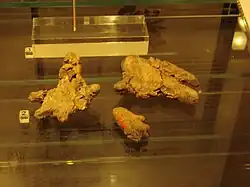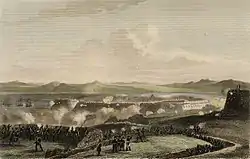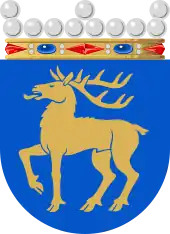
| Part of a series on |
| Scandinavia |
|---|
 |
The history of Åland can be traced back to roughly 4000 BCE, when humans first reached the archipelago in the Neolithic period.[1] Several Bronze Age villages have been found on Åland. During the Viking Age, six hillforts were built. Sweden controlled the Åland Islands from the 1200s until 1809, during which, Kastelholm Castle was the focal point of many battles. In 1809, the Russian empire took Åland and Finland. In 1854, British and French forces attacked Bomarsund. The Åland Islands were then demilitarised until 1906. In 1918, Swedish and German forces occupied the Åland Islands. After the Finnish Civil War, Åland joined Finland following the Åland Convention of 1921.
Geology and prehistory
Paleolithic period
Around 18,000 BC, during the Weichselian glaciation, a thick cover of ice stretched over Scandinavia,[2] which eventually receded from the islands around 9000 BC.[3] Around 8000 BC the highest peaks of the then submerged archipelago rose from the Baltic Sea.[4] The sea levels would alternate in the Baltic Sea,[5] but a land bridge to Åland never formed, indicating the first humans came by boat or over the ice.[1]
Due to the forebulge effect after the icecaps melted, the area around Åland is still rising several millimeters per year, marginally expanding the archipelago's surface.[6]
Neolithic period

Artifacts of human remains, pottery and animal bones were found dating as far back as the Middle Neolithic (ca. 4000 BC). These are the oldest findings, denoting human presence on the isles by then. Their cultures were Scandinavian, firstly the Pitted Ware culture and later joined by the Comb Ceramic culture.[1][7] Around this time is when the first primitive agriculture begins.[8]
Bronze Age
Many Bronze Age villages have been found on Åland. Ceramics and animal bones have been found on Kökar.[9] Signs of livestock have been found from the Bronze age on Åland.[10]
Viking age
Dense settlements were built on Fasta Åland during this time.[8] Large burial grounds have been found on Åland as well.[11] Arabic mint coins from 400 C.E. have been found on Åland.[1] On Åland, there are six hillforts from this period.[12] There was extensive trade with other areas, as far as Arabia.[8][13][14]The first signs of christianity were found from the Middle ages.[8]
Middle Ages
The first wooden churches are built on Åland.[8] [13]Åland Islands might have been occupied by Eric the Saint, other sources claim Åland was already an integral part of Sweden. The first stone churches where built in th 1300s to 1400s on Åland.[13][8]When construction began on Kastelholm Castle is not exactly known but it most likely began in the 1380s[8] [15] Kastelholm is first mentioned in 1388[15] Many noble families would live on Åland.[13] The Franciscan order would found a monestery on Hamnö in Kökar in the 1400s. [13] Åland would join the Kalmar Union.
Swedish rule
In 1507 the Danish naval officer Søren Norby would capture Kastelholm castle. [13][8]Many battles would take place between the Danish and Swedish over Kastelholm between 1521 - 1523.[8] Gustav Vasa would make Åland a royal castle county in 1537.[13] Gustav Vasa would also establish 3 large breeding farm estates. [13] Catholicism came to a end on Åland and monesteries would be closed and the churces and monesteries had give their silver to the state.[13]
Åland would become part of the Swedish Empire and many Ålanders would be enrolled for war.[13] The postal service was given a permanent route which would go from Stockholm to Turku through Åland.[8][13]
Between 1665 and 1668 the Kastelholm witch trials would take place on Åland where over 20 women would be accused of witchcraft and would be executed.[13] The first school would be founded on Åland in the 1600s in Saltvik.[13]
During the Great Northern War many Ålanders fled west from the advancing Russians.[13] The Battle of Grengam would take place in Åland during the Great Northern war on 7 August 1720.
During the Napoleonic Wars, the Russians would occupy Åland in 1808. The Treaty of Fredrikshamn would be signed by Russia and Sweden. Finland and Åland are ceded to Russia.[16][8][13]
Continuing malaria outbreaks
As the result of abundant Anopheles claviger mosquitoes, malaria was endemic in Åland for at least 150 years, with severe outbreaks being recorded in the 18th century, and in 1853 and 1862.[17]
Chronology up to 1921

- c. 1835: Fortress of Bomarsund begins construction.
- 1853: Severe malaria outbreak.[17]
- 1854 – Battle of Bomarsund: as part of the Crimean War the Anglo-French invasion of Åland takes place. The coalition force attacks and destroys the fortress of Bomarsund. The British prime minister Palmerston had protested against this fortification some twenty years prior, without effect.
- 1856 – Treaty of Paris: The peace convention forbids the fortification of the Islands.[18]
- March 1856: By the Åland Convention, concluded between the United Kingdom, France and Russia, it was decided the isles were demilitarized.
- 1862: Another severe malaria outbreak occurs.[17]
- 1877: A telegraph cable is in use from Mariehamn to Nystad.
- 1892: The first telephone is installed in Mariehamn.[19]
- 1906: A Russian garrison is established in the Islands. Some attention went to the earlier Treaty of Paris when Russia, under pretext of stopping the smuggling of arms into Finland, placed considerable naval and military forces on the islands.
- 1907: Russia requests France and Great Britain to cancel the Convention's agreement.
- 1907: Secret Treaty of Björkö (Russia and Germany), which gives Russia a free hand to install military forces on the Islands.
- 1914: Outbreak of World War I: Russia fortifies the Islands.
- 1916: The islands are remilitarised by Russia and used as a submarine base during World War I.
- 1917 – Russian Revolution: Finland declares independence. The Islanders demand reunification with Sweden via a referendum (25–29 December).
- 1918: The Soviet Government, Sweden and Germany recognise Finland's independence. Bolshevik forces, however, land on the Islands as part of the Russian Revolution. The isles are later invaded by Sweden (February) and eventually occupied by Germany (March-October).
- 1918: The islanders internationally plead to reunite with Sweden.
- 1919: Sweden brings the question before the Paris Peace Conference on 18 March but the islands remain part of Finland.[18]
- 1921: The Åland convention re-establishes the demilitarised status of the islands.
See also
References
- 1 2 3 4 Early history. (2014, September 25). Visit Åland. https://www.visitaland.com/en/good-to-know/history/early-history/ Retrieved 25 August 2021
- ↑ NASA. (2014, June 4). Åland Islands. Earthobservatory.Nasa.Gov. https://earthobservatory.nasa.gov/images/52174/aland-islands Retrieved 25 August 2021.
- ↑ Mörner, N. A. (1995). The Baltic Ice Lake-Yoldia Sea transition. Quaternary International, 27, 95-98.
- ↑ Stone Age Åland. Retrieved 29 August 2006. (in Swedish)
- ↑ Andrén, T., Björck, S., Andrén, E., Conley, D., Zillén, L., & Anjar, J. (2011). The development of the Baltic Sea Basin during the last 130 ka. In The Baltic Sea Basin (pp. 75-97). Springer, Berlin, Heidelberg.
- ↑ December 2006, Anne-Maj Lahdenperä Pöyry Environment Oy, Working Report 2006-111, Literature Review on Future Development of the Baltic Sea and Recommendations for Safety Modelling
- ↑ Götherström, A., Stenbäck, N., & Storå, J. (2002). The Jettböle middle Neolithic site on the Åland Islands–human remains, ancient DNA and pottery. European Journal of Archaeology, 5(1), 42-69.
- 1 2 3 4 5 6 7 8 9 10 11 Eriksson, Sussanne (1993). Åland Kort och gott [Åland in short] (in Swedish). Ålands landskapsstyrelse och Ålands lagting. ISBN 9518946000.
- ↑ "early history". visitaland.
- ↑ "forntiden". visitaland.
- ↑ [https:/visitaland.com/upplev/kultur-historia/alands historia/ "ålands historia"]. visitaland.
{{cite web}}: Check|url=value (help) - ↑ "Permenenta utställningar". visitaland.
- 1 2 3 4 5 6 7 8 9 10 11 12 13 14 15 Mattsson, Benita (2000). Alla Tiders Åland Från istid till EU-inträde. Ålands landskapsstyrelse. p. 55. ISBN 951894671X.
- ↑ Ilves, Kristin (2021). 101 Glimtar ur Ålands forntid. Ålands Museum. p. 36. ISBN 9789525614749.
- 1 2 "Historia kring slottet". Kastelholms slott.
- ↑ Prothero, G.W. (1920). The Åland Islands. Great Britain. Foreign Office. Historical Section. p. 9.
- 1 2 3 Prothero, G.W. (1920). The Åland Islands. Great Britain. Foreign Office. Historical Section. p. 3.
- 1 2 Prothero, G.W. (1920). The Åland Islands. Great Britain. Foreign Office. Historical Section. pp. 9–10.
- ↑ Prothero, G.W. (1920). The Åland Islands. Great Britain. Foreign Office. Historical Section. p. 6.
- This article incorporates text from a publication now in the public domain: Chisholm, Hugh, ed. (1911). "Åland Islands". Encyclopædia Britannica. Vol. 1 (11th ed.). Cambridge University Press. p. 469.
 This article incorporates text from this source, which is in the public domain: Prothero, G.W. (1920). The Åland Islands. Great Britain. Foreign Office. Historical Section. pp. 9–10.
This article incorporates text from this source, which is in the public domain: Prothero, G.W. (1920). The Åland Islands. Great Britain. Foreign Office. Historical Section. pp. 9–10.
External links
 Media related to History of Åland at Wikimedia Commons
Media related to History of Åland at Wikimedia Commons
